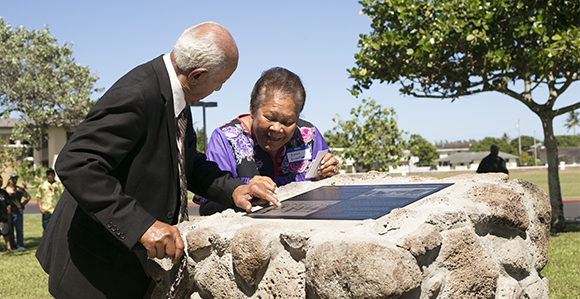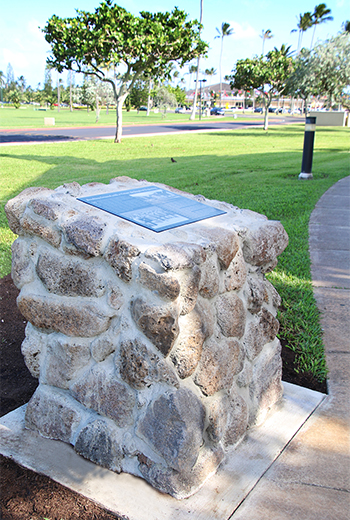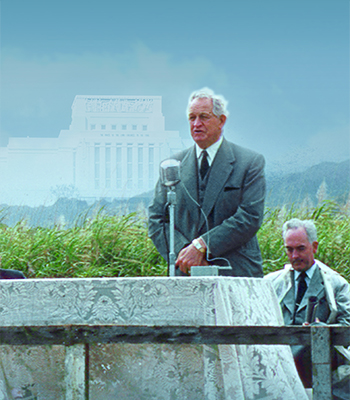Historical Marker Unveiled at BYU–Hawaii 60 Years after Groundbreaking
Contributed By Camron Stockford, Church News contributor

Packard “Pupi” Toelupe and Emma Ernestburg, both present at the 1955 groundbreaking, find Sister Ernestburg in a photo at the event commemorated by a new historical marker on the campus of BYU–Hawaii.
Article Highlights
- A new historical marker at BYU–Hawaii marks 60 years since President David O. McKay broke ground for the university.
- The marker overlooks the actual site of the groundbreaking, which took place on February 12, 1955.
- Members who were present at the groundbreaking ceremony, as well as labor missionaries who helped build the university, gathered to see the new historical marker.
“May this memorial, which resembles an altar, become our grateful ‘monument to the ages,’ memorializing a sacred spot where God’s voice was heard as He spoke through His servant, David O. McKay.” —John S. Tanner, BYU–Hawaii president
Sixty years after President David O. McKay participated in the groundbreaking for Brigham Young University–Hawaii, community members and students gathered on October 24 for the unveiling of a new historical marker on the Laie, Hawaii, campus.
The marker—which has been in the works for several years—is placed so that those who stop to read the plaque will be overlooking the actual site of the groundbreaking, which took place on February 12, 1955. The marker is made from locally secured lava rock and is built at the north end of the campus stake center. The site was determined from historical photos and accounts of community members who were present.
The unveiling event is part of the 60-year anniversary celebration of BYU–Hawaii and the 150-year anniversary celebration of the LDS Church in Laie. For a schedule of all events, visit http://www.laie150.org.
Mark James, president of the Mormon Pacific Historical Society, located the approximate location of the groundbreaking. In his speech at the unveiling, he recounted the story of then-Elder McKay and Hugh J. Cannon, son of George Q. Cannon, who traveled the world visiting all of the Church’s missions.
Upon visiting the Hawaii mission, Elder McKay witnessed a flag-raising ceremony at the local school. “[Elder McKay] was inspired by the sight of so many people from so many places coming together to learn. It was at that time that he envisioned that there would be further schooling for many people from many lands,” Brother James said.

A new historic monument marks the spot where President David O. McKay broke ground for the future Church College of Hawaii (renamed BYU–Hawaii in 1974) and blessed the community. Photo courtesy BYU–Hawaii.

A BYU–Hawaii photo montage of the Laie Hawaii Temple and President David O. McKay (by Elder Lee Cantwell) represent the prophet’s groundbreaking and blessing on the site of the future BYU–Hawaii on February 12, 1955.
Brother James also recognized those in attendance who were present at the groundbreaking ceremony, as well as any of the labor missionaries who helped build the university who had gathered to see the new historical marker.
In recognizing them for their service, he said, “We stand upon the shoulders of those who have gone before us. We appreciate those who have sacrificed so much in preparing this place, where students would come from many lands and would be able to further their education.”
Packard “Pupi” Toelupe, one of the original labor missionaries, recounted his own story of meeting the prophet, President David O. McKay, at the groundbreaking ceremony and some of the miracles surrounding the event.
“We all gathered around here. It was raining, but when his car pulled in, the rain quit. We could see the rain around, but we were not wet,” Brother Toelupe said. Brother Toelupe was later called as a labor missionary in Laie, where he learned and worked on a variety of projects during the construction of the campus.
BYU–Hawaii President John S. Tanner spoke about the significance of the university, indicating the significance of the school being built in the shadow of a temple. “I believe that is one of the reasons why President McKay wanted to build the school in the special town of Laie,” he said.
Later in his remarks, President Tanner also called BYU–Hawaii a “living laboratory for intercultural learning, where nations would come together in peace and learn to be able to associate together, bound in the gospel.”
“May this memorial, which resembles an altar, become our grateful ‘monument to the ages,’ memorializing a sacred spot where God’s voice was heard as He spoke through His servant, David O. McKay,” President Tanner said. “Let us ever remember and treasure in our hearts the inspired words spoken here.”
For more information on the 2015 Mormon Pacific Historical Society conference presentations, visit http://www.laie150.org (see “Recent Posts”).
.jpg)
A crowd gathers on Saturday, October 24, to participate in the unveiling of a new historical marker on the BYU–Hawaii campus in Laie, Hawaii. Photo courtesy BYU–Hawaii.
.jpg)
Packard “Pupi” Toelupe, Emma Ernestburg, Sione Feinga, and William Ernestburg are joined by current BYU–Hawaii students to unveil a new historical marker commemorating the 1955 groundbreaking of the university by President David O. McKay. Photo courtesy BYU–Hawaii.
.jpg)
BYU–Hawaii President John S. Tanner addresses a group of students, faculty, and community members gathered to participate in the unveiling of a new historical marker on Saturday, October 24. Photo courtesy BYU–Hawaii.
.jpg)
A plaque on top of the new historic monument explains how President David O. McKay’s experience with the Laie mission school children in 1921 led to his breaking ground for the Church College of Hawaii (now BYU–Hawaii) and blessing the community on February 12, 1955. Photo courtesy BYU–Hawaii.
